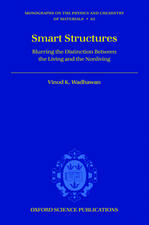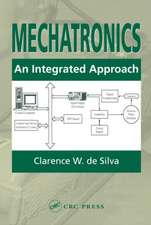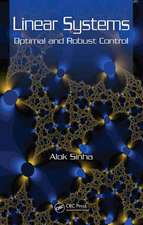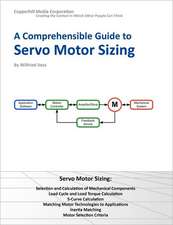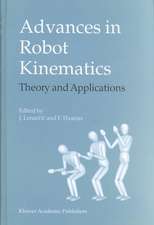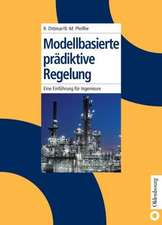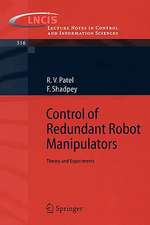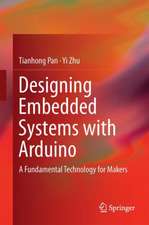Robotics
Autor Matjaž Mihelj, Tadej Bajd, Aleš Ude, Jadran Lenarčič, Aleš Stanovnik, Marko Munih, Jure Rejc, Sebastjan Šlajpahen Limba Engleză Paperback – 4 ian 2019
It addresses the following subjects: a general introduction to robotics; basic characteristics of industrial robot mechanisms; position and movement of an object, which are described by homogenous transformation matrices; a geometric model of robot mechanisms expanded with robot wrist orientation description in this new edition; a brief introduction to the kinematics and dynamics of robots; robot sensors and planning of robot trajectories; fundamentals of robot vision; basic control schemes resulting in either desired end-effector trajectory or force; robot workcells with feeding devices and robot grippers.
This second edition has been expanded to include the following new topics: parallel robots;collaborative robots; teaching of robots; mobile robots; and humanoid robots. The book is optimally suited for courses in robotics or industrial robotics and requires a minimal grasp of physics and mathematics.
The 1st edition of this book won the Outstanding Academic Title distinction from the library magazine CHOICE in 2011.
| Toate formatele și edițiile | Preț | Express |
|---|---|---|
| Paperback (1) | 421.60 lei 38-44 zile | |
| Springer International Publishing – 4 ian 2019 | 421.60 lei 38-44 zile | |
| Hardback (1) | 458.26 lei 38-44 zile | |
| Springer International Publishing – 13 aug 2018 | 458.26 lei 38-44 zile |
Preț: 421.60 lei
Nou
Puncte Express: 632
Preț estimativ în valută:
80.68€ • 87.61$ • 67.77£
80.68€ • 87.61$ • 67.77£
Carte tipărită la comandă
Livrare economică 18-24 aprilie
Preluare comenzi: 021 569.72.76
Specificații
ISBN-13: 9783030102852
ISBN-10: 3030102858
Pagini: 251
Ilustrații: IX, 251 p. 175 illus.
Dimensiuni: 155 x 235 x 18 mm
Greutate: 0.37 kg
Ediția:Softcover reprint of the original 2nd ed. 2019
Editura: Springer International Publishing
Colecția Springer
Locul publicării:Cham, Switzerland
ISBN-10: 3030102858
Pagini: 251
Ilustrații: IX, 251 p. 175 illus.
Dimensiuni: 155 x 235 x 18 mm
Greutate: 0.37 kg
Ediția:Softcover reprint of the original 2nd ed. 2019
Editura: Springer International Publishing
Colecția Springer
Locul publicării:Cham, Switzerland
Cuprins
1 Introduction.- 2 Homogenous transformation matrices.- 3 Geometric description of the robot mechanism.- 4 Orientation of robot gripper.- 5 Two-segment robot manipulator.- 6 Robot sensors.- 7 Trajectory planning.- 8 Robot control.- 9 Robot teaching.- 10 Parallel robots.- 11 Collaborative robots.- 12 Mobile robots.- 13 Humanoid robots.- 14 Robot workcells.
Notă biografică
Matjaž Mihelj (Ph.D., University of Ljubljana, 2002) is a Full Professor at the University of Ljubljana. His research interests are in human-robot interaction, rehabilitation robotics, and wearable sensors. He has authored or coauthored over 40 journal publications and 9 monographs, and holds 3 patents. His contributions have been recognized with several national and international awards.
Tadej Bajd (Ph.D., University of Ljubljana, 1979) is President of the Slovenian Academy of Sciences and Arts, a Professor Emeritus at the University of Ljubljana, and a Fellow of the IEEE, AIMBE, and EAMBES. He is a member of the European Academy of Sciences and Arts and Slovenian Academy of Engineering. He is the author or coauthor of over 100 journal papers and several monographs.
Jadran Lenarčič (Ph.D., University of Ljubljana, 1986) is currently Director of the J. Stefan Institute, Ljubljana. His basic research interests include robotics, robot kinematics, biorobotics and humanoid robotics. He has edited a series of books on Advances in Robot Kinematics, and is a member of both the Slovenian Academy of Engineering and Accademia delle scienze di Bologna.
Aleš Ude (Ph.D., University of Karlsruhe, 1995) is Head of the Department of Automatics, Biocybernetics, and Robotics at J. Stefan Institute, Ljubljana, and an Associate Professor at the University of Ljubljana. His research interests include robot sensorimotor learning, robot vision, humanoid robotics, and cognition.
Aleš Stanovnik, (Ph.D., University of Ljubljana, 1980) is a Professor Emeritus of Physics with the University of Ljubljana. His research chiefly focused on experimental nuclear and particle physics. He is the author of a physics textbook and author or coauthor of more than 80 papers in scientific journals.
Sebastjan Šlajpah (Ph.D., University of Ljubljana, 2015) is a Teaching Assistant for courses in the fields of robotics, robot control, and human-robot interaction. Hisresearch is focused on wearable sensors, haptics, collaborative robotics, and robot control.
Jure Rejc (Ph.D., University of Ljubljana, 2008) is a researcher and Teaching Assistant for robotics and embedded systems. In addition, he works to develop robot-based applications and solutions for high-precision industrial measurements.
Marko Munih (Ph.D., University of Ljubljana, 1993) is a Full Professor and Head of the Robolab at the University of Ljubljana. His research is focused on robots in interaction and haptic interfaces, as well as robots in construction and measurement work. He has authored or coauthored 120 peer-reviewed journal articles and 4 textbooks, and holds 5 patents.
Tadej Bajd (Ph.D., University of Ljubljana, 1979) is President of the Slovenian Academy of Sciences and Arts, a Professor Emeritus at the University of Ljubljana, and a Fellow of the IEEE, AIMBE, and EAMBES. He is a member of the European Academy of Sciences and Arts and Slovenian Academy of Engineering. He is the author or coauthor of over 100 journal papers and several monographs.
Jadran Lenarčič (Ph.D., University of Ljubljana, 1986) is currently Director of the J. Stefan Institute, Ljubljana. His basic research interests include robotics, robot kinematics, biorobotics and humanoid robotics. He has edited a series of books on Advances in Robot Kinematics, and is a member of both the Slovenian Academy of Engineering and Accademia delle scienze di Bologna.
Aleš Ude (Ph.D., University of Karlsruhe, 1995) is Head of the Department of Automatics, Biocybernetics, and Robotics at J. Stefan Institute, Ljubljana, and an Associate Professor at the University of Ljubljana. His research interests include robot sensorimotor learning, robot vision, humanoid robotics, and cognition.
Aleš Stanovnik, (Ph.D., University of Ljubljana, 1980) is a Professor Emeritus of Physics with the University of Ljubljana. His research chiefly focused on experimental nuclear and particle physics. He is the author of a physics textbook and author or coauthor of more than 80 papers in scientific journals.
Sebastjan Šlajpah (Ph.D., University of Ljubljana, 2015) is a Teaching Assistant for courses in the fields of robotics, robot control, and human-robot interaction. Hisresearch is focused on wearable sensors, haptics, collaborative robotics, and robot control.
Jure Rejc (Ph.D., University of Ljubljana, 2008) is a researcher and Teaching Assistant for robotics and embedded systems. In addition, he works to develop robot-based applications and solutions for high-precision industrial measurements.
Marko Munih (Ph.D., University of Ljubljana, 1993) is a Full Professor and Head of the Robolab at the University of Ljubljana. His research is focused on robots in interaction and haptic interfaces, as well as robots in construction and measurement work. He has authored or coauthored 120 peer-reviewed journal articles and 4 textbooks, and holds 5 patents.
Textul de pe ultima copertă
This book introduces readers to robotics, industrial robot mechanisms, and types of robots, e.g. parallel robots, mobile robots and humanoid robots. The book is based on over 20 years of teaching robotics and has been extensively class tested and praised for its simplicity.
It addresses the following subjects: a general introduction to robotics; basic characteristics of industrial robot mechanisms; position and movement of an object, which are described by homogenous transformation matrices; a geometric model of robot mechanisms expanded with robot wrist orientation description in this new edition; a brief introduction to the kinematics and dynamics of robots; robot sensors and planning of robot trajectories; fundamentals of robot vision; basic control schemes resulting in either desired end-effector trajectory or force; robot workcells with feeding devices and robot grippers.
This second edition has been expanded to include the following new topics: parallel robots;collaborative robots; teaching of robots; mobile robots; and humanoid robots. The book is optimally suited for courses in robotics or industrial robotics and requires a minimal grasp of physics and mathematics.
The 1st edition of this book won the Outstanding Academic Title distinction from the library magazine CHOICE in 2011.
It addresses the following subjects: a general introduction to robotics; basic characteristics of industrial robot mechanisms; position and movement of an object, which are described by homogenous transformation matrices; a geometric model of robot mechanisms expanded with robot wrist orientation description in this new edition; a brief introduction to the kinematics and dynamics of robots; robot sensors and planning of robot trajectories; fundamentals of robot vision; basic control schemes resulting in either desired end-effector trajectory or force; robot workcells with feeding devices and robot grippers.
This second edition has been expanded to include the following new topics: parallel robots;collaborative robots; teaching of robots; mobile robots; and humanoid robots. The book is optimally suited for courses in robotics or industrial robotics and requires a minimal grasp of physics and mathematics.
The 1st edition of this book won the Outstanding Academic Title distinction from the library magazine CHOICE in 2011.
Caracteristici
Expanded, second edition of the book that won the Outstanding Academic Title distinction from the library magazine CHOICE in 2011 Includes robotics course material (slides) on extras.springer.com Provides an essential introduction for engineers and computer scientists, requiring only a minimal grasp of physics and mathematics

